After having a wonderful time in Sikkim for a month, we arrived in Darjeeling in the state of West Bengal in India.
Darjeeling is a city located at about 2000m elevation in the Lesser Himalayas. This city is famous around the world for its Darjeeling Tea. This place is also home to the Darjeeling Himalayan Railway, which is a UNESCO World Heritage Site.
During our time in Sikkim, we were constantly searching for places to stay in Darjeeling but they were expensive and way above our typical budget. There was one new place on Airbnb that kept pulling us towards it. Especially because of the views of Kanchenjunga mountain (8586m/28169ft) from the balcony of the house. We were checking the prices of that place regularly on Airbnb as they were changing everyday. And to our surprise one day the prices dropped a lot and we immediately tried to book the place online, but before we completed our booking the prices went back up again. We contacted the host and negotiated a price that was close to what was offered on the site the previous day. As the host was new and it was his first house on Airbnb, he wanted guests to come in and provide feedback so he could make necessary improvements, instead of keeping the house empty for a long time. It worked out nicely for both of us.
Our Jeep from Yuksom, Sikkim dropped us about one kilometre away from the house as the exact location was unclear for us from the website. We contacted the host and he gave us the directions to get to his place. The walk was nice and we got to see a bit of our neighbourhood before we arrived at our home. Our host was waiting to receive us when we got there. Similar to many homes in Sikkim, this was also a four storied building built along the mountain slopes with one floor above the road level and three below. Our home was one level below the road level. The home itself was an old apartment of our host's ancestors that they recently turned into a homestay. No one seemed to have lived in that house before for more than a day or two. Our host was eager for feedback, so by the end of our stay, based on our experience staying in many Airbnbs around the world, we provided them with a long list of suggestions on how they could make the place more comfortable for their future guests.
Our home in Darjeeling was next to the touristy Himalayan Railway line. We could hear the train and its steam engine pass by regularly during the day. Whenever we heard the whistle of the engine from far, Nora was excited to come out to the balcony and see the train. The train tracks were just next to the often narrow road and it was exciting to see a big train pass by so close to the homes and shops. We spent around two weeks in Darjeeling. As it was the monsoon season, there were heavy rains almost every day with the sun peeking out for an hour or so everyday. Drying clothes was definitely a challenge for us in this weather, especially because we use cloth diapers for Nora and we had to dry them regularly. We had our own kitchen with all the necessary utensils to cook our meals. We bought fruits, vegetables, and groceries from nearby local stores and cooked most of our meals ourselves at home.
During our two weeks here, we mostly walked along the streets, went on hikes, visited a few nearby temples and a monastery, talked to the local shopkeepers, and spent time at home cooking, reading, and playing with Nora.
From Darjeeling we wanted to enter Northeast India and explore that part of India for some time. We were unsure how the journey was going to be as the rains were heavy due to the monsoon season and most of the roads were blocked and many rivers were overflowing. We were ready for the adventure and we started our journey towards Guwahati in the neighbouring state of Assam. We took a Jeep from Darjeeling back to Siliguri, stayed there overnight at a hotel, and took the train in the morning to Guwahati.
We arrived in Guwahati in the evening. The weather was very different compared to Darjeeling. Darjeeling had temperatures ranging from 10ºC - 20ºC (50F - 68F) but the temperatures in Guwahati were ranging from 25ºC - 35ºC (77F - 95F). Also the monsoon season was in full force when we arrived in Assam. During the train ride, we could see from our windows the flooded fields and open areas. Many trains in that direction were cancelled due to the water level rising above the railway tracks in many parts. The water level in the Brahmaputra river was slowly inching towards the danger mark. Our plans of staying in Guwahati for a few days and heading on to the neighbouring state of Meghalaya did not happen due to multiple reasons. All of us felt that we needed some physical rest for a few days before we could travel further from Guwahati. And by the time we were ready, the roads were closed and the flooding in the rivers had reached the danger mark. Brahmaputra river was officially flooding many parts of Guwahati and the advisory was that it had officially crossed the danger mark. Our few days in Guwahati turned into two weeks and we changed our plans to head back to West Bengal and come back to Northeast India at a later time. We stayed in three different places while we were in Guwahati and we got to meet locals and got a chance to speak to them. We also met some curious students on the roads during our walks and had chats with them. And one family that hosted us even invited us to have a meal with them and shared a bit about their culture and the stories of their son who was also traveling around India for the past few years.
We were unsure until we left Guwahati whether our train would leave on that day or not, as the rains were heavy in many parts of India, and many train routes were cancelled. Luckily we were able to leave Guwahati as planned. It was an overnight train and we reached Kolkata the next day.
Kolkata, which was called Calcutta until 2001, is the capital of the state of West Bengal in India. To our surprise, it was one of the cleanest cities we've seen in India so far. The roads were very clean, and trash was separated for recycling and composting in many places. Everywhere in India, it was a common sight to see plastic bags/bottles and trash on the streets and on abandoned lands. We couldn't find any of that in Kolkata except at a few temples. We spent around 2 weeks in this city. Kolkata has a population of around 4.5 million people and is famous for it's British era architecture, cable cars, yellow taxis, local trains, sweets, and bridges. We booked a place on Airbnb and it was an independent apartment inside a multi storied building. The location was way outside the city centre and in a neighbourhood with no tourists. So, it gave us a good opportunity to meet locals, talk to them, and see a bit of their ways of living. The temperatures were peaking up to 35ºC (95F) everyday so we tried to go out as little as possible during the day and stayed indoors. But on a few cloudy days, we went out and explored a bit of Kolkata and its architecture.
After about two months in this area, we started heading back to South India to prepare for the arrival of our second baby. We had one more stop on our plans before we got back to Ibrahimpatnam - it was Odisha.
Darjeeling is a city located at about 2000m elevation in the Lesser Himalayas. This city is famous around the world for its Darjeeling Tea. This place is also home to the Darjeeling Himalayan Railway, which is a UNESCO World Heritage Site.
During our time in Sikkim, we were constantly searching for places to stay in Darjeeling but they were expensive and way above our typical budget. There was one new place on Airbnb that kept pulling us towards it. Especially because of the views of Kanchenjunga mountain (8586m/28169ft) from the balcony of the house. We were checking the prices of that place regularly on Airbnb as they were changing everyday. And to our surprise one day the prices dropped a lot and we immediately tried to book the place online, but before we completed our booking the prices went back up again. We contacted the host and negotiated a price that was close to what was offered on the site the previous day. As the host was new and it was his first house on Airbnb, he wanted guests to come in and provide feedback so he could make necessary improvements, instead of keeping the house empty for a long time. It worked out nicely for both of us.
Our Jeep from Yuksom, Sikkim dropped us about one kilometre away from the house as the exact location was unclear for us from the website. We contacted the host and he gave us the directions to get to his place. The walk was nice and we got to see a bit of our neighbourhood before we arrived at our home. Our host was waiting to receive us when we got there. Similar to many homes in Sikkim, this was also a four storied building built along the mountain slopes with one floor above the road level and three below. Our home was one level below the road level. The home itself was an old apartment of our host's ancestors that they recently turned into a homestay. No one seemed to have lived in that house before for more than a day or two. Our host was eager for feedback, so by the end of our stay, based on our experience staying in many Airbnbs around the world, we provided them with a long list of suggestions on how they could make the place more comfortable for their future guests.
Our home in Darjeeling was next to the touristy Himalayan Railway line. We could hear the train and its steam engine pass by regularly during the day. Whenever we heard the whistle of the engine from far, Nora was excited to come out to the balcony and see the train. The train tracks were just next to the often narrow road and it was exciting to see a big train pass by so close to the homes and shops. We spent around two weeks in Darjeeling. As it was the monsoon season, there were heavy rains almost every day with the sun peeking out for an hour or so everyday. Drying clothes was definitely a challenge for us in this weather, especially because we use cloth diapers for Nora and we had to dry them regularly. We had our own kitchen with all the necessary utensils to cook our meals. We bought fruits, vegetables, and groceries from nearby local stores and cooked most of our meals ourselves at home.
During our two weeks here, we mostly walked along the streets, went on hikes, visited a few nearby temples and a monastery, talked to the local shopkeepers, and spent time at home cooking, reading, and playing with Nora.
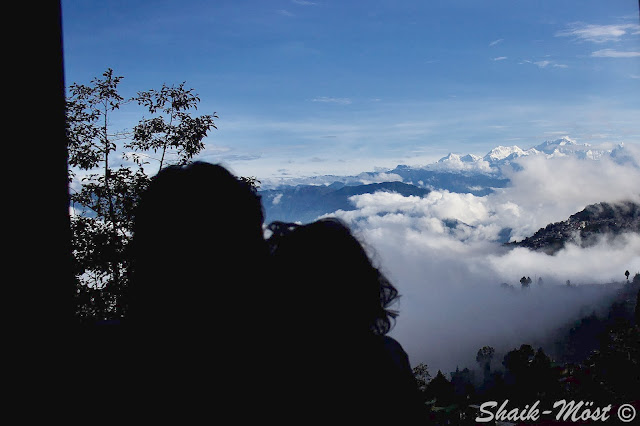 | |
|
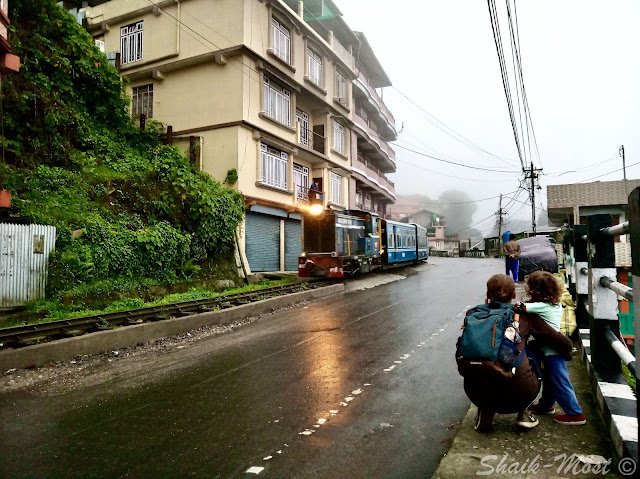 |
| Kathi and Nora watching the Darjeeling Himalayan train passing by our neighbourhood |
 |
| (A typical day in Darjeeling)View from the street onto the steep many storied buildings |
 |
| Kathi and Nora enjoying the heavy fog and rainwater in-front of Dali Monastery |
 |
| A mobile temple with two calfs on-board and people collecting donations |
From Darjeeling we wanted to enter Northeast India and explore that part of India for some time. We were unsure how the journey was going to be as the rains were heavy due to the monsoon season and most of the roads were blocked and many rivers were overflowing. We were ready for the adventure and we started our journey towards Guwahati in the neighbouring state of Assam. We took a Jeep from Darjeeling back to Siliguri, stayed there overnight at a hotel, and took the train in the morning to Guwahati.
We arrived in Guwahati in the evening. The weather was very different compared to Darjeeling. Darjeeling had temperatures ranging from 10ºC - 20ºC (50F - 68F) but the temperatures in Guwahati were ranging from 25ºC - 35ºC (77F - 95F). Also the monsoon season was in full force when we arrived in Assam. During the train ride, we could see from our windows the flooded fields and open areas. Many trains in that direction were cancelled due to the water level rising above the railway tracks in many parts. The water level in the Brahmaputra river was slowly inching towards the danger mark. Our plans of staying in Guwahati for a few days and heading on to the neighbouring state of Meghalaya did not happen due to multiple reasons. All of us felt that we needed some physical rest for a few days before we could travel further from Guwahati. And by the time we were ready, the roads were closed and the flooding in the rivers had reached the danger mark. Brahmaputra river was officially flooding many parts of Guwahati and the advisory was that it had officially crossed the danger mark. Our few days in Guwahati turned into two weeks and we changed our plans to head back to West Bengal and come back to Northeast India at a later time. We stayed in three different places while we were in Guwahati and we got to meet locals and got a chance to speak to them. We also met some curious students on the roads during our walks and had chats with them. And one family that hosted us even invited us to have a meal with them and shared a bit about their culture and the stories of their son who was also traveling around India for the past few years.
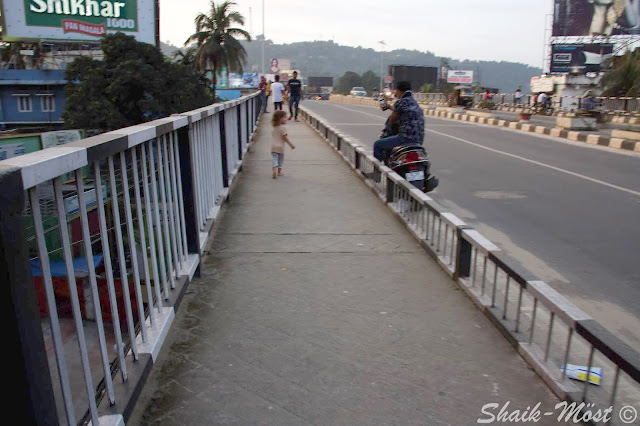 |
| Nora running along a flyover bridge and interacting with locals in Guwahati |
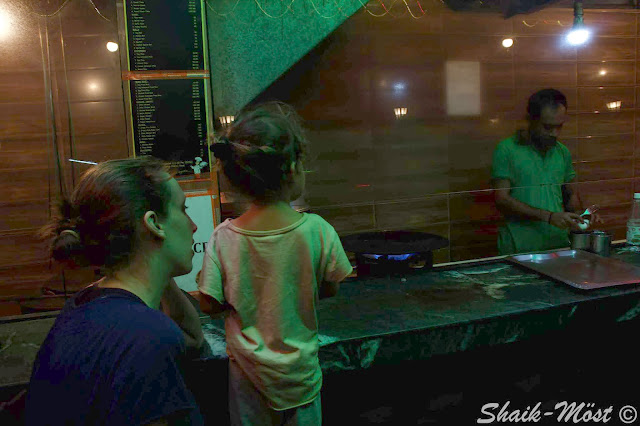 |
| Nora watching an egg parantha being made for us |
 |
| Nora and Kathi with an elephant at the Zoo in Guwahati |
 |
| Nora and Kathi feeding leaves to two Moose at the Zoo in Guwahati |
 |
| Kathi and Nora on a swing next to our room in one of our stays in Guwahati |
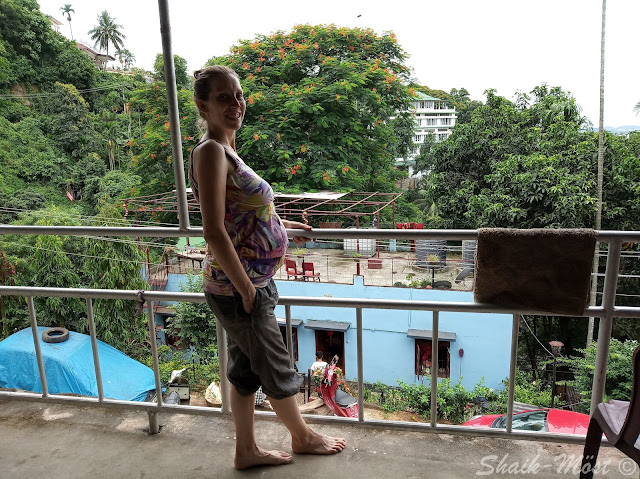 |
| Kathi posing with her belly in Guwahati at one of our stays |
We were unsure until we left Guwahati whether our train would leave on that day or not, as the rains were heavy in many parts of India, and many train routes were cancelled. Luckily we were able to leave Guwahati as planned. It was an overnight train and we reached Kolkata the next day.
Kolkata, which was called Calcutta until 2001, is the capital of the state of West Bengal in India. To our surprise, it was one of the cleanest cities we've seen in India so far. The roads were very clean, and trash was separated for recycling and composting in many places. Everywhere in India, it was a common sight to see plastic bags/bottles and trash on the streets and on abandoned lands. We couldn't find any of that in Kolkata except at a few temples. We spent around 2 weeks in this city. Kolkata has a population of around 4.5 million people and is famous for it's British era architecture, cable cars, yellow taxis, local trains, sweets, and bridges. We booked a place on Airbnb and it was an independent apartment inside a multi storied building. The location was way outside the city centre and in a neighbourhood with no tourists. So, it gave us a good opportunity to meet locals, talk to them, and see a bit of their ways of living. The temperatures were peaking up to 35ºC (95F) everyday so we tried to go out as little as possible during the day and stayed indoors. But on a few cloudy days, we went out and explored a bit of Kolkata and its architecture.
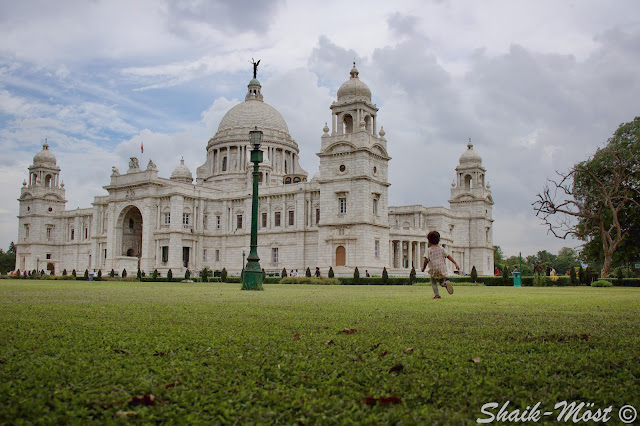 |
| Nora running in-front of Victoria Memorial |
 |
| A typical yellow taxi in Kolkata |
 |
| A typical colourful bus in Kolkata |
 |
| A hand-pulled rickshaw in Kolkata |
 |
| Passengers waiting for the the local train at a busy station in Kolkata |
 |
| Some children diving into the drainage water to pickup the coins thrown into it by devotees at a temple |
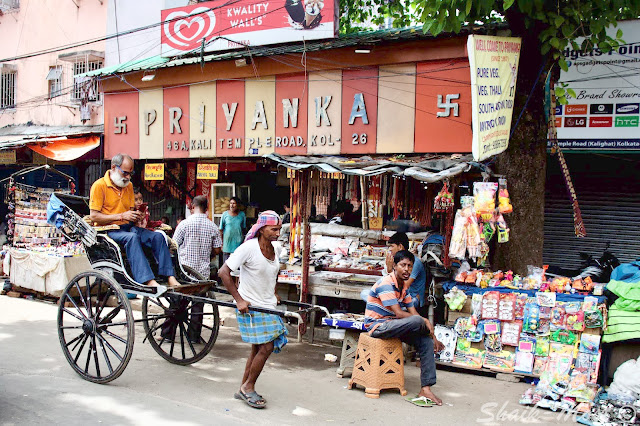 |
| A hand-pulled rickshaw in Kolkata |
 |
| Nora walking on the platform of a local train in Kolkata |
After about two months in this area, we started heading back to South India to prepare for the arrival of our second baby. We had one more stop on our plans before we got back to Ibrahimpatnam - it was Odisha.
Comments
Post a Comment